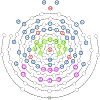Signatures of emotional face processing measured by event-related potentials in 7-month-old infants
- PMID: 36811377
- PMCID: PMC9978929
- DOI: 10.1002/dev.22361
Signatures of emotional face processing measured by event-related potentials in 7-month-old infants
Abstract
The ability to distinguish facial emotions emerges in infancy. Although this ability has been shown to emerge between 5 and 7 months of age, the literature is less clear regarding the extent to which neural correlates of perception and attention play a role in processing of specific emotions. This study's main goal was to examine this question among infants. To this end, we presented angry, fearful, and happy faces to 7-month-old infants (N = 107, 51% female) while recording event-related brain potentials. The perceptual N290 component showed a heightened response for fearful and happy relative to angry faces. Attentional processing, indexed by the P400, showed some evidence of a heightened response for fearful relative to happy and angry faces. We did not observe robust differences by emotion in the negative central (Nc) component, although trends were consistent with previous work suggesting a heightened response to negatively valenced expressions. Results suggest that perceptual (N290) and attentional (P400) processing is sensitive to emotions in faces, but these processes do not provide evidence for a fear-specific bias across components.
Keywords: N290; Nc; P400; emotions; face processing; infant ERP.
© 2022 Wiley Periodicals LLC.
Conflict of interest statement
Conflict of interest
The authors declare that they have no known competing financial interests or personal relationships that could have appeared to influence the work reported in this paper.
Figures



Similar articles
-
Neural correlates of facial emotion processing in infancy.Dev Sci. 2019 May;22(3):e12758. doi: 10.1111/desc.12758. Epub 2018 Oct 16. Dev Sci. 2019. PMID: 30276933 Free PMC article.
-
Looking to the eyes influences the processing of emotion on face-sensitive event-related potentials in 7-month-old infants.Dev Neurobiol. 2015 Oct;75(10):1154-63. doi: 10.1002/dneu.22204. Epub 2014 Jun 26. Dev Neurobiol. 2015. PMID: 24962465 Free PMC article.
-
Three-month-old infants show enhanced behavioral and neural sensitivity to fearful faces.Dev Cogn Neurosci. 2020 Apr;42:100759. doi: 10.1016/j.dcn.2020.100759. Epub 2020 Jan 28. Dev Cogn Neurosci. 2020. PMID: 32072932 Free PMC article.
-
Attention and emotion: An integrative review of emotional face processing as a function of attention.Cortex. 2020 Sep;130:362-386. doi: 10.1016/j.cortex.2020.06.010. Epub 2020 Jul 6. Cortex. 2020. PMID: 32745728 Review.
-
Event-related brain potential correlates of emotional face processing.Neuropsychologia. 2007 Jan 7;45(1):15-31. doi: 10.1016/j.neuropsychologia.2006.04.022. Epub 2006 Jun 22. Neuropsychologia. 2007. PMID: 16797614 Free PMC article. Review.
Cited by
-
Maternal anxiety during pregnancy predicts infant attention to affective faces.J Affect Disord. 2024 Jan 1;344:104-114. doi: 10.1016/j.jad.2023.09.031. Epub 2023 Oct 5. J Affect Disord. 2024. PMID: 37802320 Free PMC article.
References
-
- Bayet L, & Nelson CA (2019). The perception of facial emotion in typical and atypical development. In LoBue V, Pérez-Edgar K, & Buss KA (Eds.), Handbook of Emotional Development (pp. 105–138). Springer International Publishing. 10.1007/978-3-030-17332-6_6 - DOI
-
- Beliveau A & Thorley J (2021). sims: Simulate Data from R or 'JAGS' Code. https://cran.r-project.org/web/packages/sims/index.html
Publication types
MeSH terms
Grants and funding
LinkOut - more resources
Full Text Sources

